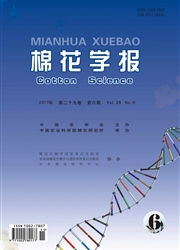

 中文摘要:
中文摘要:
以杂交种中棉所75和常规种鲁棉研28为材料,从冠层、单株以及单铃内部几个不同层次深入研究了密度对产量及产量构成因子的影响。结果表明,密度显著影响棉花产量,且这种影响可追溯到单株,甚至单个棉铃内部的单个种子上。5.1万株和8.7万株·hm-2密度下皮棉产量无显著差异,但显著高于1.5万株·hm-2密度的产量。在该试验密度范围,随着密度增加,棉株上部果枝和外围果节的成铃率显著降低;铃重、单粒种子截面积和单铃内种子数随密度增加呈下降趋势;单粒种子上纤维质量与种子所处位置相关,在棉铃基部和中部其随密度变化差异较大。
 英文摘要:
英文摘要:
Two cultivars-a hybrid cultivar (CCRI 75) and conventional cotton (SCRC 28)-were used for field experiments in 2012 and 2013. This study was designed to determine how cotton (Gossypium hirsutum L.) yield components at the canopy, per plant and within-boll levels were affected by planting density. As our result show, lint yield was significantly affected by planting den- sity, which can be occurred in the plant and even within the boll. Lint yield was significantly higher when 10,000 plants, hm-2 were grown in fields of 5.1 and 8.7 than in fields of 1.5. This study shows that boll retention in upper fruit nodes and outer fruit positions reduced significantly as planting density increased. Boll weight, seed area and seed number per boll decreased with in- crease in planting density. The effect of planting density on lint yield per seed was greater in the bottom and middle seed posi- tions than in the apex seed position. These findings are significant with respect to optimal planting density and eultivar breeding.
 同期刊论文项目
同期刊论文项目
 同项目期刊论文
同项目期刊论文
 期刊信息
期刊信息
